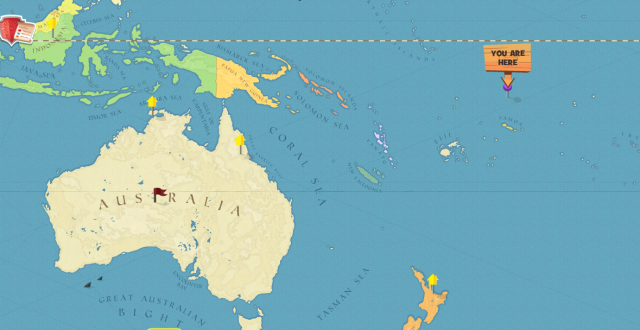Tokelau
Area 3.86 square mi (10 square km)
Population 1,418 (2004)
Capital none
Highest Point 16 ft (5 m)
Lowest Point 0 m
GDP per capita $1,000 (estimate 1993)
Primary Natural Resources copra, fisheries, craft goods.
A COUNTRY LOCATED in the South PACIFIC OCEAN halfway between HAWAII and NEW ZEALAND, Tokelau covers a huge area of ocean but only a tiny area of land. The total land area of the three atolls, Atafu, Nukunonu, and Fakaofo, is just 3.86 square mi (12 square km), with the largest atoll, Nukumonu, 1.81 square mi (4.7 square km) in size. The atolls are essentially each a reef-bound islet surrounding a lagoon. While the climate in the atolls is fairly constant and averages 82 degrees F (28 degrees C), the islands are often threatened by cyclones. The atolls are also under threat from rising sea levels.

The islands have been inhabited for approximately 1,000 years; the first Europeans visited in 1765. Catholic Samoans settled for a short while on the islands to convert the population to Western religions. In the mid-1800s, the population suffered greatly when Peruvian slave traders captured around 250 people and missionaries removed another 500. The islands were annexed by Britain in 1889 and the administration was handed over to New Zealand in 1925, where control has remained since.
The population of Tokelau is just under 1,500 and almost exclusively Polynesian. The languages spoken are Tokelauan and English. Traditional Polynesian culture systems still exist and land is controlled by chiefs and is passed down from generation to generation. Daily operations are organized by village leaders and family representatives, and traditional male and female work and family roles have been maintained. The only major influence that Western culture has had on the society is through religion, with almost 100 percent of the nation practicing either Roman Catholicism or Congregationalism. There are no guns on any of the islands, and alcohol is extremely limited.
Although each of the atolls has its own administrative center, the nation is ruled externally by New Zealand, which appoints an administrator to head the Office for Tokelau Affairs, based in New Zealand. The citizens are classed as citizens of New Zealand, and therefore have the right to migrate whenever they wish. In the 1970s, population growth was threatening the survival of the nation, and New Zealand began to offer incentives for people to migrate to New Zealand, and this has resulted in a community of around 3,000 Tokelauans now living in New Zealand. New Zealand also provides defense services for the country.
New Zealand contributes about 80 percent of the budget to support public administration, as well as community and infrastructure development and maintenance. The public service economic sector is the main employer in the country, all administered from New Zealand.
Unlike many other South Pacific countries, tourism in Tokelau is little developed. Travel to the islands is difficult, as there is no airport and the anchorages can be quite unsafe. One ocean vessel does travel monthly from Samoa, but needs to dock at sea and visitors have to be transported to the islands by small boat.